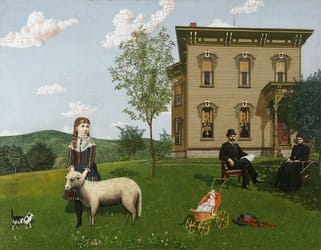

Mourning Picture, 1890
Edwin Romanzo Elmer
Mourning Picture is a family portrait of the artist, his wife, and their daughter, who had died not long before, and a pet sheep against the backdrop of a Victorian house. It was first shown in a post office in 1890 and then was not seen again until 1950 when the artist's niece showed it to Henry-Russell Hitchcock, then director of the Smith Museum. Hitchcock recognized its value at once. It became one of the most popular and most frequently reproduced paintings in the collection.
[http://history927.rssing.com/chan-9198012/all_p6.html]
Mourning Picture
The little-known American artist Edwin Ramanzo Elmer painted this strange and arresting work after the death from appendicitis of his 9-year-old daughter Effie. Here she is portrayed with her pet lamb and kitten, against the clapboard house her father built in Western Massachusetts. The remote and rigid figures of the artist and his wife appear in mourning clothes, though the painting was only given its title decades later, and not by the artist. The narrative voice in Adrienne Rich’s poem belongs to the dead Effie, the couple’s only child. Hauntingly, she compares the veins of the lilac leaf to her father’s “grief-tranced hand”.
The following poem is illustrated by the painting that directly inspired the poet.
Mourning Picture, Adrienne Rich (1965)
They have carried the mahogany chair and the cane rocker
out under the lilac bush,
and my father and mother darkly sit there, in black clothes.
Our clapboard house stands fast on its hill,
my doll lies in her wicker pram
gazing at western Massachusetts.
This was our world.
I could remake each shaft of grass
feeling its rasp on my fingers,
draw out the map of every lilac leaf
or the net of veins on my father's
grief-tranced hand.
Out of my head, half-bursting,
still filling, the dream condenses--
shadows, crystals, ceilings, meadows, globes of dew.
Under the dull green of the lilacs, out in the light
carving each spoke of the pram, the turned porch-pillars,
under high early-summer clouds,
I am Effie, visible and invisible,
remembering and remembered.
[http://www.theartsdesk.com/visual-arts/listed-poems-inspired-paintings]
Uploaded on Feb 12, 2018 by Suzan Hamer
Edwin Romanzo Elmer
artistArthur
Wait what?

